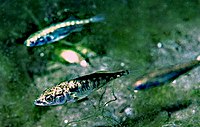
Photo from wikipedia
Colour pattern is the main trait that drives mate recognition between Heliconius species that are phylogenetically close. However, when this cue is compromised such as in cases of mimetic, sympatric… Click to show full abstract
Colour pattern is the main trait that drives mate recognition between Heliconius species that are phylogenetically close. However, when this cue is compromised such as in cases of mimetic, sympatric and closely related species, alternative mating signals must evolve to ensure reproductive isolation and species integrity. The closely related species Heliconius melpomene malleti and H. timareta florencia occur in the same geographical region, and despite being co-mimics, they display strong reproductive isolation. In order to test which cues differ between species, and potentially contribute to reproductive isolation, we quantified differences in the wing phenotype and the male chemical profile. As expected, the wing colour pattern was indistinguishable between the two species, while the chemical profile of the androconial and genital males' extracts showed marked differences. We then conducted behavioural experiments to study the importance of these signals in mate recognition by females. In agreement with our previous results, we found that chemical blends and not wing colour pattern drive the preference of females for conspecific males. Also, experiments with hybrid males and females suggested an important genetic component for both chemical production and preference. Altogether, these results suggest that chemicals are the major reproductive barrier opposing gene flow between these two sister and co-mimic species.
Journal Title: Proceedings of the Royal Society B: Biological Sciences
Year Published: 2020
Link to full text (if available)
Share on Social Media: Sign Up to like & get
recommendations!